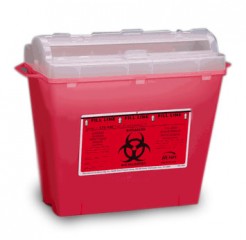The Potentially Infectious Material/Bloodborne Pathogens Program affects a variety of areas on campus. As a result, many employees and students may perform tasks that are covered by this policy. These tasks involve much more than working only with human blood. An employee or student is covered by this policy if they work with or are potentially exposed to any of the following materials:
- Blood which includes human blood, human blood components and products made from human blood.
- Human body fluids including: semen, vaginal secretions, cerecerebrospinal fluid, synovial fluid, plural fluid, pericardial fluid, peritoneal fluid, amniotic fluid, salvia in dental procedures and any body fluid visibly contaminated with blood.
- Any unfixed tissue or organ (other than intact skin) from a human living or dead.
- Cell, tissue or organ cultures from humans or experimental animals unless known and proven to be free of bloodborne pathogens.
- Blood, organs, or other tissues from experimental animals unless known and proven to be free of bloodborne pathogens.
- Culture medium unless known and proven to be free of bloodborne pathogens.
Procedures and specifications for working with or handling potentially infectious material are covered in the Potentially Infectious Material/Bloodborne Pathogens Program Manual. This program encompasses all persons who work in jobs or as a part of their academic instruction may reasonably be exposed to those materials. This could include students or employees in teaching or research laboratories, police officers, housekeepers, emergency response personnel, health care providers and others.
The basic steps of the program are as follows:
- Contact EHS for additional information related to the Bloodborne Pathogen Program.
- Annually Departments and Units complete Risk Appraisal Surveys online through Veoci to determine if employees or students are at risk for exposure to bloodborne pathogens or other potentially infectious materials (OPIM).
- Following a completed Risk Appraisal Survey, in which it is determined that employees and/or students have an anticipated risk to Bloodborne Pathogens or OPIM, EHS will request establishment of an Exposure Control Plan. This Exposure Control Plan will also be completed through Veoci and require identification and use of universal precautions, engineering controls, work practice controls, personal protective equipment and labels/signage as referenced in the Potentially Infectious Material/Bloodborne Pathogens Program Manual and the UA Biosafety Program.
- In addition to the Risk Appraisal and Exposure Control Plan created on Veoci, Departments and Units must also include, as part of their Exposure Control Plan operations, a Sharps Evaluation and Sharps Injury Log. EHS has provided, for departmental use, a generic Sharps Evaluation and Sharps Injury Log.
- Departments/Units must provide Bloodborne Pathogen training to potentially exposed personnel and students. EHS provides training opportunities related to Bloodborne Pathogens in a variety of methods such as instructor-led training, computer-based training (Skillsoft Academy), and direct peer-to-peer training. Additionally, EHS recognizes some departments or units may train employees/students internally, or utilize a 3rd Party Safety Training provider. As such, EHS reviews and approves other avenues of training as requested.
- A record of all safety training for each employee is required to be kept on file by the employee and their supervisor. All individuals attending required instructor-led or peer-to-peer training provided by EHS or a third-party training provider will sign an attendance roster. The information on this attendance roster, as well as any learning measurement exercises associated with the training, will be maintained by the respective training provider. For more information pertaining to Safety Training and related documentation see the UA Safety Training Policy.
- The Hepatitis B Vaccination Information and Consent Form for vaccinations is provided by the medical provider upon evaluation. Otherwise the Hepatitis B Vaccination Decline to Accept Form must be completed for declination statements. Records of vaccination status can be maintained using the Documentation of Student/Employee Hepatitis B Vaccination Status (a generic form to track the Hepatitis B vaccination process).
- Contact EHS anytime someone is potentially exposed to infectious materials, including needle sticks, spills, accidents, injuries, and near misses.
- Make available post exposure evaluation and follow up to those who experience an exposure incident.
For guidance and further information on the Bloodborne Pathogen Policy as it relates to research or academic laboratories or functions, contact EHS.
For further information as it relates to facilities or other service areas, contact EHS.